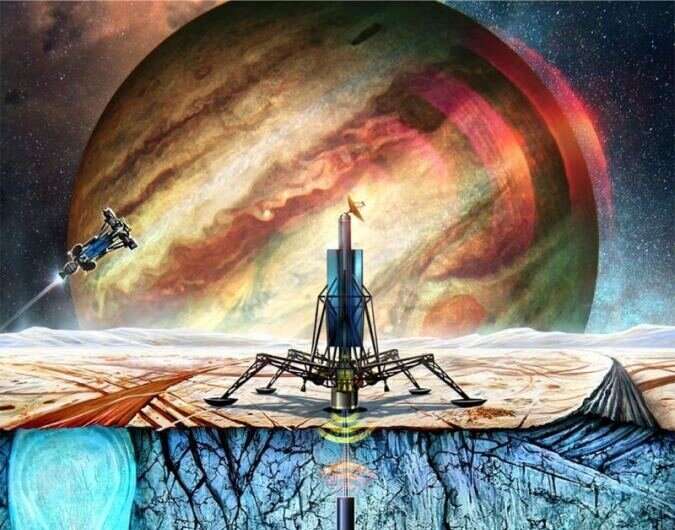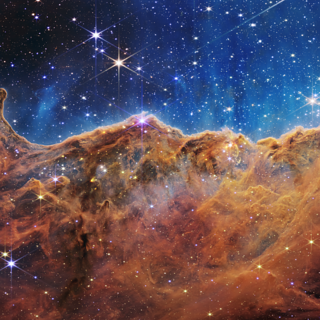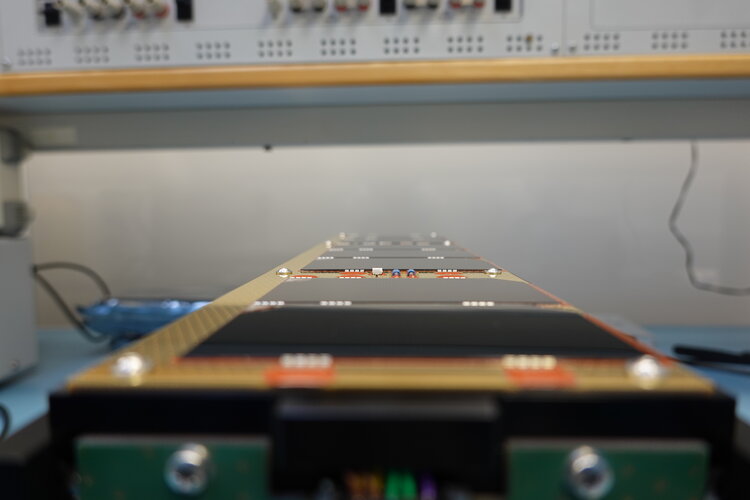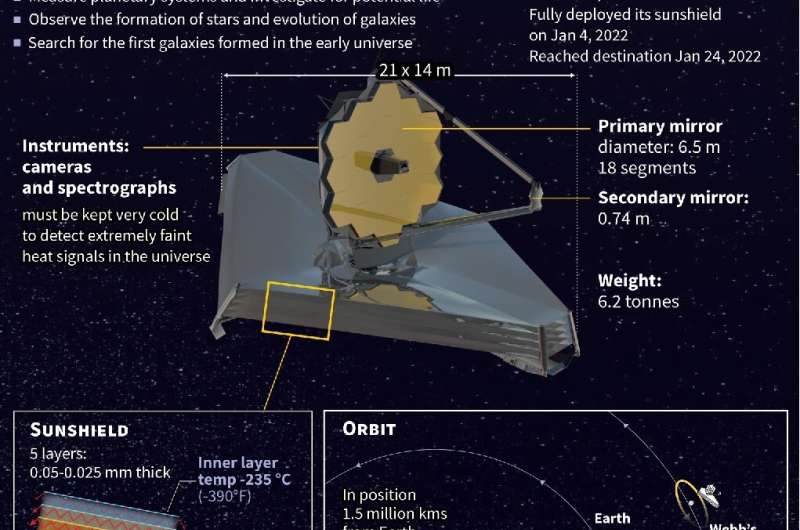A swarm of swimming robots to search for life under the ice on Europa
Tuesday, 12 July 2022 12:59
When Galileo pointed his telescope at Jupiter 400 years ago, he saw three blobs of light around the giant planet, which he at first thought were fixed stars.
Uncontrolled rocket descents pose a 10% risk of killing one or more people over the next ten years
Tuesday, 12 July 2022 12:10
Space cybersecurity firm SpiderOak adds retired general Pawlikowski to its advisory board
Tuesday, 12 July 2022 12:01
Space cybersecurity firm SpiderOak on July 12 announced the appointment of former DoD and military officials to its advisory board.
The post Space cybersecurity firm SpiderOak adds retired general Pawlikowski to its advisory board appeared first on SpaceNews.
BAE Systems delivers jam-resistant GPS receivers to Germany
Tuesday, 12 July 2022 12:00
BAE Systems delivered to Germany advanced GPS M-code receivers.
The post BAE Systems delivers jam-resistant GPS receivers to Germany appeared first on SpaceNews.
NASA Reveals Webb Telescope’s First Images of Unseen Universe
Tuesday, 12 July 2022 11:21 The dawn of a new era in astronomy has begun as the world gets its first look at the full capabilities of NASA’s James Webb Space Telescope, a partnership with ESA (European Space Agency) and CSA (Canadian Space Agency).
The dawn of a new era in astronomy has begun as the world gets its first look at the full capabilities of NASA’s James Webb Space Telescope, a partnership with ESA (European Space Agency) and CSA (Canadian Space Agency). China to target near-Earth object 2020 PN1 for asteroid deflection mission
Tuesday, 12 July 2022 11:12
China has set its sights on near-Earth object 202 PN1 as the target for a combined asteroid deflection and observation test mission due to launch in 2026.
The post China to target near-Earth object 2020 PN1 for asteroid deflection mission appeared first on SpaceNews.
AI CubeSat headed to Van Allen Belts on Vega-C
Tuesday, 12 July 2022 10:58
An ESA-financed nanosatellite, due to lift off aboard the inaugural flight of Vega-C this Wednesday, will operate an AI system in the harsh, radiation-wracked environment of the Van Allen Belts. The shoebox-sized Trisat-R – one of six ‘CubeSats’ on the flight, headed up to a rarely-trafficked close to 6000 km altitude orbit – is also carrying radiation-detection payloads from CERN, the European Council for Nuclear Research, Slovenian firm SkyLabs and ESA itself.
James Webb Telescope to release more breathtaking cosmic views
Tuesday, 12 July 2022 10:40
After unveiling the clearest view yet of the distant cosmos, the James Webb Space Telescope has more to come.
The next wave of images on Tuesday will reveal details about the atmosphere of a faraway gas planet, a "stellar nursery" where stars form, a "quintet" of galaxies locked in a dance of close encounters, and the cloud of gas around a dying star.
They will be published starting from 10:30 am Eastern Time (1430 GMT), in an event live streamed from the NASA Goddard Space Flight Center, just outside Washington.
Targets include Carina Nebula, a stellar nursery, famous for its towering pillars that include "Mystic Mountain," a three-light-year-tall cosmic pinnacle captured in an iconic image by Hubble.
Webb has also carried out a spectroscopy—an analysis of light that reveals detailed information—on a gas giant planet called WASP-96 b, which was discovered in 2014.
Nearly 1,150 light-years from Earth, WASP-96 b is about half the mass of Jupiter and zips around its star in just 3.4 days.
Earth imagery companies reimagine satellite tasking
Tuesday, 12 July 2022 10:35
Earth observation startups and established firms have streamlined satellite tasking.
The post Earth imagery companies reimagine satellite tasking appeared first on SpaceNews.
BlackSky and Esri unveil tasking through ArcGIS Online
Tuesday, 12 July 2022 10:30
BlackSky Technology unveiled satellite tasking July 12 through Esri’s ArcGIS Online geographic mapping platform.
The post BlackSky and Esri unveil tasking through ArcGIS Online appeared first on SpaceNews.
NASA's Webb Telescope Is Now Fully Ready for Science
Tuesday, 12 July 2022 10:21 The months-long process of preparing NASA's James Webb Space Telescope for science is now complete. All of the seventeen ways or 'modes' to operate Webb's scientific instruments have now been checked out, which means that Webb has completed its commissioning activities and is ready to begin full scientific operations.
Each of Webb's four scientific instruments has multiple modes of operati
The months-long process of preparing NASA's James Webb Space Telescope for science is now complete. All of the seventeen ways or 'modes' to operate Webb's scientific instruments have now been checked out, which means that Webb has completed its commissioning activities and is ready to begin full scientific operations.
Each of Webb's four scientific instruments has multiple modes of operati Prospecting for Interstellar Oil
Tuesday, 12 July 2022 10:21 We have developed a new method to look for carbon compounds in space, akin to prospecting for oil on Earth. Between the stars lie vast amounts of interstellar gas and dust, spread thinly throughout our Galaxy.
The dust can contain compounds of carbon. When it does we call it carbonaceous interstellar dust. This is an important reservoir for the organic material in space. The continual cycl
We have developed a new method to look for carbon compounds in space, akin to prospecting for oil on Earth. Between the stars lie vast amounts of interstellar gas and dust, spread thinly throughout our Galaxy.
The dust can contain compounds of carbon. When it does we call it carbonaceous interstellar dust. This is an important reservoir for the organic material in space. The continual cycl The life puzzle: the location of land on a planet can affect its habitability
Tuesday, 12 July 2022 10:21 New climate models have found that the amount and location of land on a planet's surface can significantly impact its habitability. Astronomers have identified substantial differences in surface temperature, sea ice and water vapour across a planet's surface for different land configurations. The work will be presented on Monday 11 July at the National Astronomy Meeting (NAM 2022) by Evelyn Macd
New climate models have found that the amount and location of land on a planet's surface can significantly impact its habitability. Astronomers have identified substantial differences in surface temperature, sea ice and water vapour across a planet's surface for different land configurations. The work will be presented on Monday 11 July at the National Astronomy Meeting (NAM 2022) by Evelyn Macd MIT design for Mars propellant production trucks wins NASA competition
Tuesday, 12 July 2022 10:21 Using the latest technologies currently available, it takes over 25,000 tons of rocket hardware and propellant to land 50 tons of anything on the planet Mars. So, for NASA's first crewed mission to Mars, it will be critical to learn how to harvest the red planet's local resources in order to "live off the land" sustainably.
On June 24, NASA announced that an MIT team received first place i
Using the latest technologies currently available, it takes over 25,000 tons of rocket hardware and propellant to land 50 tons of anything on the planet Mars. So, for NASA's first crewed mission to Mars, it will be critical to learn how to harvest the red planet's local resources in order to "live off the land" sustainably.
On June 24, NASA announced that an MIT team received first place i Advanced Navigation sets sight to be the first Australian company to reach the Moon
Tuesday, 12 July 2022 10:21 Advanced Navigation, one of the world's most determined innovators in AI robotics, and navigation technology has announced its ambitions to be the first Australian company to reach the Moon through its development of two unique navigation systems.
"The team is absolutely thrilled to see years of research in development progress into successful technology. We look forward to being the first
Advanced Navigation, one of the world's most determined innovators in AI robotics, and navigation technology has announced its ambitions to be the first Australian company to reach the Moon through its development of two unique navigation systems.
"The team is absolutely thrilled to see years of research in development progress into successful technology. We look forward to being the first 
